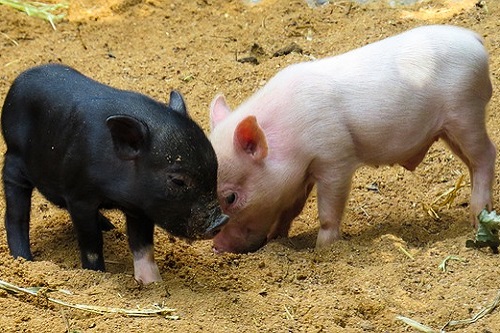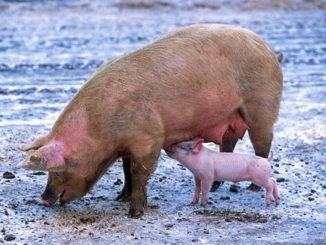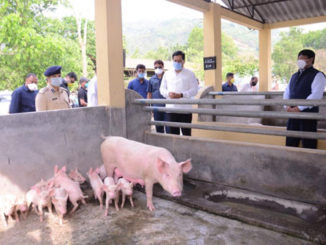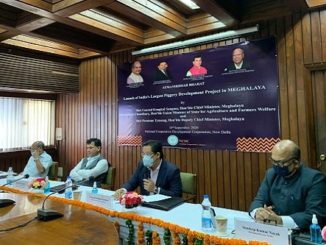Introduction
Iron deficiency in piglets leads to abnormality in the levels of red blood cells around the body. Piglet anemia is a hypochromic microcytic anemia decreases the capability of these cells to carry on oxygen from the lungs to the tissues causes damages such as weight loss, immune deficiency associated with infectious disease. That causes significant mortality and high piglet refugee rate. This is generally associated with young, rapidly growing piglets deprive of iron in their diet or from their environment.
The absence of haemoglobin as much as is necessary can be caused by iron deficiency, anaemia, liver disease, helminthiasis, infections, inflammatory bowel disease, and other diseases that vary depending on the severity of the piglet anaemia
Iron is a vital component in forming hemoglobin, a protein comprising about one-third the weight of the red blood cell. The pig is born with a normal level of hemoglobin in the blood of 12-13g/100ml and this rapidly drops down to 6-7g by 10 to 14 days of age. A shortage of iron results in lowered levels of hemoglobin in the red cells, a lowered capacity for the carriage of oxygen around the body and an increased susceptibility to disease. When there is a deficiency of iron, the baby pig cannot synthesize an adequate amount of hemoglobin. Indoors the pig has no access to iron other than to the sows’ milk (which is deficient) until it starts to eat creep feed.
Causes of Iron Deficiency
Iron deficiency develops rapidly in nursing pigs reared in confinement because of
- Low body storage of iron in the newborn pig
- Low iron content of sow’s colostrum and milk,
- Elimination of contact with iron from soil, and
- The rapid growth rate of the nursing pig.
The baby pig is born with a total of about 40mg of iron in his body, most of which is present in the form of hemoglobin in blood and storage forms in the liver. With an iron requirement of about 7mg daily to maintain blood hemoglobin level in the normally growing baby pig, it is apparent that without supplemental iron, body stores will not last very long.
Low iron content of sow’s colostrum and milk
The concentration of iron in colostrum is seldom greater than 2ppm, and in milk is lower, averaging about 1ppm. Because of the low concentration of iron in sow’s milk, the baby pig cannot obtain more than about 1mg of iron daily from this source. This falls far short of his requirement for 7mg daily. Thus, under natural conditions piglet could obtain his iron from the soil. When the pig is placed on concrete or reared in confinement in a central farrowing facility, he is denied this opportunity.
Rapid growth rate of the nursing pig
The baby pig has a tremendous ability to grow and rapid growth of the nursing pig with the resulting increase in plasma volume demands a high intake of iron to maintain adequate hemoglobin
Deficiency Symptoms of Iron
The most common parameter to indicate Fe-deficient anemia is hemoglobin concentration. In 1979, the National Research Council created a classification system by which pigs could be categorized base on the extent of the anemia by their Hb concentration, measured in grams/ deciliter as follows:
- Pigs with Hb levels 10 or above are
- Hb level of 9 is the minimum level for optimum performance.
- Hb level of 8 indicates a borderline anemia.
- Hb level of 7 is the level in which anemia retards growth.
- Hb level of 6 is considered severe anemia and 4 as severe anemia with increase mortality.
The first sign of iron deficient anemia is roughness of hair coat and loss of pigmentation of mucus membrane. The skin is wrinkle, pigs exhibit listlessness, characterized by drooping of the head and ears combine with lack of appetite, diarrhea and reduce weight gain.
In severe cases, pigs may be identified by dyspnea, increase heart and respiratory rates, the pigs die suddenly due to anoxia. Anemic pigs show higher susceptibility to infectious diseases (such as pneumonia, influenza and GIT disorders) because a dietary Fe level is directly related to antibody production Diagnosis This is based on the clinical signs, the lack of any supplemental iron and the hemoglobin level in the blood. If this is less than 8g/100ml the piglet is becoming anemic.

Treatment and Prevention of Piglet Anemia
Several management approaches include
- Iron can also be provided in piglets drinking water, with a dispenser placed in the creep area. 1.8% Ferrous sulfate @ 4ml/day for seven days starts from birth onwards.
- Iron sulfate paste can be painted on the sows teats for every 2-3 days.
- The easiest method is to give the piglet an injection of 150- 200mg of iron dextran in either a 1 or 2 ml dose. Iron is best given from 3 to 5 days of age and not at birth, because a 2 ml dose at birth causes considerable trauma to the muscles and repeat on 14th day.
- Raise iron levels in lactating sow diets so that litters receive more iron, sourced not from the sow’s milk but her dung.
Economic Impact
Iron deficiency in pigs if not managed and treated properly can lead to economic losses to pig farmers on large scale as there will be high mortality of piglets within 15 days of farrowing resulting in very small litter size. It will lead to decrease in in the production ultimately thus financial losses to farmer.
Conclusion
In India, pig production has a considerable importance as a source of income generation. This production system is mainly affected by climate, social and religious beliefs and deficiency problems. Iron deficiency is a major deficiency problem that occurs in newborn pigs whose sole source of iron is the milk of dam. The major factors that compound the deficiency problems are very low iron store at birth, low levels of iron in sow’s milk and very rapid growth rates of piglets. Pig owners should be advised and educated about proper feeding and management of piglets. Supplementation of iron to piglets and pregnant sows should be encouraged in order to prevent iron deficiency problem.
References
- Ashmead H.D.W. (2001) The Absorption and Metabolism of Iron Amino Acid Chelate. Arch Latinoam Nutr 51 (Suppl 1): 13-21.
- Egeli A.K., Framstad T. (1999) An Evaluation of Iron-Dextran Supplementation in Piglets Administered by Injection on the First, Third or Fourth Day after Birth. Res Vet Sci 66 (3): 179-184
- Hunter A.A. (1963) Piglet Anaemie. Agriculture 38: 115
- Mc Donald F.F., Dunlop D., Bates C.M. (1955) An Effective Treatment for Anaemia of Piglets. Br. Vet. J. 111: 403-407
- Svoboda M., Drabek. J., (2005) Iron Deficiency in Suckling Piglets: Etiology, Clinical Aspects and Diagnosis. Folia Vet 49: 104-111
- Wang J., Li D., Che L., Lin Y., Fang Z., (2014) Influence of Organic Iron Complex on Sow Reproductive Performance and Iron Status of Nursing Pigs. Livestock Science 160: 89-96.
| The content of the articles are accurate and true to the best of the author’s knowledge. It is not meant to substitute for diagnosis, prognosis, treatment, prescription, or formal and individualized advice from a veterinary medical professional. Animals exhibiting signs and symptoms of distress should be seen by a veterinarian immediately. |






Be the first to comment